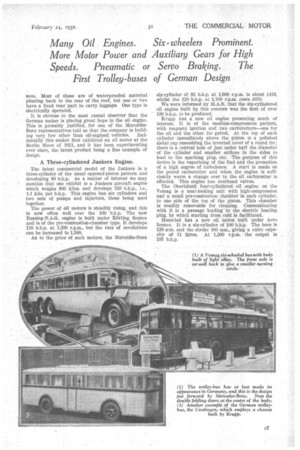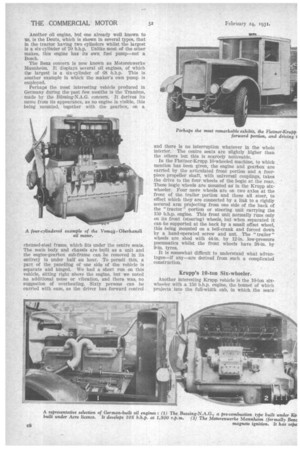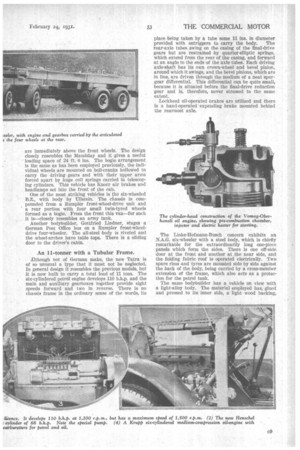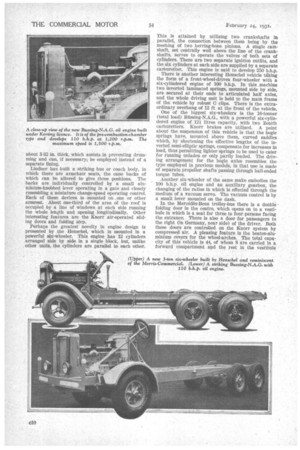Pointers from
Page 56

Page 57

Page 58

Page 59

Page 60

Page 61

If you've noticed an error in this article please click here to report it so we can fix it.
THE BERLIN SHOW
IN this report of the exhibits at the International Motor Show, which is now being held in Berlin, we have not attempted to describe those chassis and vehicles which approach very closer to British design, nor have we dealt wth the French, American and British products which are rell known to our readers. We must state, however, that the display. of Morris-commercial chassis, including the Dictator and six-wheeler, created great interest.
Many amalgamations lidve taken place in the German industry, and these have resulted in concentration on fewer models and the virtual elimination of many examples of freak design, although a few are left and there are one or two new arrivals, such as the monster Flettner-Krupp 15-tonner with 10 wheels, about which we shall have more to say.
The average German chassis is a far more massivelooking affair than is ours, and it is difficult to understand how they can legally carry the loads for which they are intended, the weight limits in Germany being II tons for four-wheelers and 16 tons for those with six or more wheels. Great progress is, of course, being made in the use of light alloys both for chassis and bodies, and this undoubtedly helps to a considerable extent. Bureaucracy in Germany does not seem so biased against road transport as it does in Britain, and not long ago the speed limit for pneumatic-tyred vehicles of all classes was altogether abolished. This move has resulted in the development of big vehicles in which the engine power has been greatly increased ; the Vomag six-wheeler, for example, has a 12-cylindered Maybach unit of 150 b.h.p., the capacity being close upon eight litres, and this is not the only commercialvehicle engine with 12 cylinders.
In order to limit the engine speed, also to promote fuel economy when high rates of travel are required, much use is being made of auxiliary gearboxes, of which the most popular example is the Maybach, the changing of the ratios in this being effected either by compressed air or by a vacuum servo. The ordinary gear-changing is, however, done in the usual manner.
At last efforts are being made to popularize the trolley-bus, and two creditable vehicles of this type are on view—the Mercedes-Benz and the Uerdingen, the latter having a Krupp chassis.
Steel and Light Alloys for Bodies.
Much attention is being paid to bodywork, and there are some excellent examples. Wood bodies are almost conspicuous by their absence, the favoured materials being steel and light alloys, or in some eases a combination of these. There is a squareness. about many of them which is not pleasing to the eye that is familiar with our well-curved British vehicle.
All-weather coaches have increased rapidly, and whereas at the show of two years ago there were only one or two patterns, now some half a dozen are to be seen. Most of these are of waterproofed material pleating back to the rear of the roof, but one or two have a fixed rear part to carry luggaga One type is electrically operated.
It is obvious to the most casual observer that the German maker is placing great hope in the oil engine. This is probably justified, for one of the Merc60sBenz representatives told us that the company is building very few other than oil-engined vehicles. Incidentally this maker first exhibited an oil motor at the Berlin Show of 1921, and it has been experimenting ever since, the latest product being a fine example of design.
A Three-cylindered Junkers Engine.
The latest commercial model of the Junkers is a three-cylinder of the usual opposed-piston pattern and developing 80 b.h.p. As a matter of interest we may mention that one exhibit is a Junkers aircraft engine which weighs 800 kilos. and develops 720 b.h.p., i.e., 1.1 kilo. per b.h.p. This engine has six cylinders and two sets of pumps and injectors, these being -used together.
• The power of oil motors is steadily rising, and this is now often well over the 100 b.h.p. The new Bussing-N.A.G. engine is built under Kiirting licence and is of the pre-combustion-chamber type. It develops 310 b.h.p. at 1,200 r.p.m., but the rate of revolutions can be increased to 1,500.
As to the price of such motors, the Mercedc\s-Benz six-cylinder of 85 b.h.p. at 1,600 r.p.m. is about £416, whilst the 120 b.h.p. at 1,700 r.p.m. costs £670.
We were informed by MAN. that the six-cylindered oil engine built by this concern was the first of over 100 b.h.p. to be produced.
Krupp has a new oil engine presenting much of interest. It is of the •medium-eompression pattern, with magneto ignition and two carburetters—one for• the oil and the other for petrol. At the top of each cylinder immediately above the piston is a polished metal cap resembling the inverted cover of a round tin; there is a central hole of just under half the diameter of the cylinder and smaller orifices in the sides to lead to the sparking plug, etc. The purpose of this device is the vaporizing of the fuel and the promotion of a high degree of turbulence. A start is made on the petrol carburetter and when the engine is sufficiently warm a change over to the oil carburetter is effected. This engine has overhead valves.
The Oberhfinsli four-cylindered oil engine on the Vomag is a neat-looking unit with high-compression and a small pre-combustion chamber in each cylinder, to one side of the top of the piston. This chamber is readily •removable for cleaning. Communicating with it is a passage leading to the electric heating plug, by which starting from cold is facilitated.
Henschel has a new oil motor built under Acro licence. It is a six-cylinder of 100 b.h.p. The bore is 120 mm, and the stroke 160 mm., giving a cubic capacity of 11 litres. At 1,500 r.p.m. the output is 105 b.h.p. Another oil engine, but one already well known to us, is the Deutz, which is shown in several types, that in the tractor having two cylinders whilst the largest is a six-cylinder of 70 b.h.p. Unlike most of the other makes, this engine has its own fuel pump—not a Bosch.
The Benz concern is now known as Motorenwerke Mannheim. It displays several oil engines, of which the largest is a six-cylinder of 68 b.h.p. This is another example in which the maker's own pump is employed. Perhaps the most interesting vehicle produced in Germany during the past few months is the Trambug, made by the Bilssing,-N.A.G. concern. It derives its name from its appearance, as no engine is visible, this being mounted, together with the gearbox, on a channel-steel frame, which .fits under the centre seats. The main body and chassis are built as a unit and the engine-gearbox sub-frame can be removed in its entiretY in under half an hour. To permit this, a part of the panelling of one side of the vehicle is separate and hinged. We had a short run on this vehicle, sitting right above the engine, but we noted no additional noise or vibration, and there was, no suggestion of overheating. Sixty persons can be carried with ease, as the driver has forward control and there is no interruption whatever in the whole interior. The centre seats are slightly higher than the others but this is scarcely noticeable.
In the Flettner-Krupp 10-wheeled machine, to which mention has been given, the engine and gearbox are carried by the articulated front portion and a fourpiece propeller shaft, with universal couplings, takes the drive to the four wheels of the bogie at the rear.. These bogie wheels are mounted as in the Krupp sixwheeler. Four more wheels are on two axles at the front of the trailer portion and these all steer, to effect which they are connected by a link to a rigidly secured arm projecting from one side of the back of the " tractor " portion or steering unit carrying the 150 b.h.p. engine. This front unit normally runs only on its front (steering) wheels, but when separated it can be supported at the back by a small offset wheel, this being mounted on a bell-crank and forced down by a hand-operated screw and nut. The "trailer" wheels are shod with 44-in. by 12-in, low-pressure pneumatics whilst the front wheels have 38-in. by 9-in. tyres.
It is somewhat difficult to understand what advantages—if any—are derived from such a complicated construction.
Krupp's 1.0-ton Six-wheeler.
Another interesting Krupp vehicle is the 10-ton sixwheeler with a 150 b.h.p. engine, the bonnet of which projects into the full-width cab, in which the seats are immediately above the front wheels. The design closely resembles the Maudslay and it gives a useful loading space of 24 ft. 6 ins. The bogie arrangement is the same as has been employed previously, the individual wheels are mounted on bell-cranks hollowed to carry the driving gears and with their upper arms forced apart by huge coil springs carried in telescoping cylinders. This vehicle has Knorr air brakes and headlamps set into the front of the cab.
One of the most striking vehicles is the six-wheeled B.Z., with body by Ullstein. The chassis is compounded from a Bumpier front-wheel-drive unit and a rear portion with four small twin-tyred wheels formed as a bogie. From the front this van--for such it is—closely resembles an army tank.
Another bodybuilder, Gottfried Lindner, stages a German Post Office bus on a Bumpier front-wheeldrive four-wheeler. The all-steel body is riveted and the wheel-arches have table tops. There is a sliding • door to the driver's cabin.
An 11-tonner with a Tubular Frame.
Although not of German make, the new Tatra is of so unusual a type that it must not be neglected. in general design it resembles the previous models, but it is now built to carry a total load of 11 tons. The six-cylindered petrol engine develops 110 b.h.p. and the main and auxiliary gearboxes together provide eight speeds forward and two in reverse. There is no chassis frame in the ordinary sense of the words, its
place being taken by a tube some 11 ins. in diameter
provided with outriggers to carry the body. The rear-axle tubes swing on the casing of the final-drive gears but are restrained by quarter-elliptic springs, Which extend from the rear of the casing, and forward at an angle to the ends of the axle tubes. Each driving axle-shaft has its own crown-wheel and bevel pinion, around which it swings, and the bevel pinions, which are in line, are driven through the medium of a neat spurgear differential. This differential can be quite small, because it is situated before the final-drive reduction gear and is, therefore, never stressed to the same extent.
Lockheed oil-operated brakes are utilized and there is a hand-operated expanding brake mounted behind the rearmost axle.
The Linke-Hofmann-Busch concern exhibits an N.A.G. six-wheeler with a steel body, which is chiefly remarkable for the extraordinarily long one-piece panels which form the sides. There is one off-side door at the front and another at the near side, and the folding fabric roof is operated electrically. Two spare rims and tyres are mounted side by side against the back of the body, being carried by a cross-member extension of the frame, which also acts as a protection for the petrol tank.
The same bodybuilder has a vehicle on view with a light-alloy body. The material employed has, glued and pressed to its inner side, a light wood backing, about 3-32 in. thick, which assists in preventing drumming and can, if necessary, be employed instead of a separate lining.
Lindner has built a striking bus or coach body, in which there are armchair seats, the cane backs of which can be altered to give three positions. The backs are individually controlled by a small aluminium-knobbed lever operating in a gate and closely resembling a miniature change-speed operating control. Each of these devices is -mounted on one or other armrest. About one-third of the area of the roof is occupied by a line of windows at each side running the whole length and opening longitudinally. Other interesting features are the Knorr air-operated sliding doors and folding step.
Perhaps the greatest novelty in engine design is presented by the Henschel, which is mounted in a • powerful six-wheeler. This engine has 12 cylinders arranged side by side in a single block, but, unlike other units, the cylinders are parallel to each other.
This is attained by utilizing two crankshafts in parallel, the connection between them being by the meshing of two herring-bone pinions. A single camshaft, set centrally well above the line of the crankshafts, serves to operate the valves of both sets of cylinders. There are two separate ignition outfits, and the six cylinders at each side are supplied by a separate carburetter. This engine is said to develop 250 b.h.p.
There is• another interesting Henschel vehicle taking the form of a front-wheel-driven four-wheeler with a six-cylindered engine of 100 b.h.p. In this machine two inverted laminated springs, mounted side by side, are secured at their ends to articulated half axles, and the whole driving unit is held to the main frame of the vehicle by robust C clips. There is the extraordinary overhang of 12 ft. at the front of the vehicle.
One of the biggest six-wheelers is the 16-tonner (total load) Bussing-N.A.G., with a powerful six-cylindered engine of 12+ litres capacity, with two Zenith carburetters. Knorr brakes are utilized. A point about the suspension of this vehicle is that the bogie springs have, mounted above them, curved saddles which, by shortening the effective lengths of the inverted semi-elliptic spring-s, compensate for increases in load, thus permitting lighter springs to be used to eater for running unladen or only partly loaded. The driving arrangement for the bogie axles resembles the type employed in previous models, in that use is made of separate propeller shafts passing through ball-ended torque tubes.
Another six-wheeler of the same make embodies the 100 b.h.p. oil engine and an auxiliary gearbox, the changing of the ratios in which is effected through the medium of a vacuum servo. The vacuum control is by a small lever mounted on the dash.
In the Merc6as-Benz trolley-bus there is a double • folding door in the centre, which opens on to a vestibule in which is a seat for three to four persons facing the entrance. There is also a door for passengers to the right (in Germany, near side) of the driver. Both these doors are controlled on the ICnorr system by compressed air. A pleasing feature is the beaten-aluminium covers for the wheel-arches. The total capqcity of this vehicle is 44, of whom 8 are carried in a forward compartment and the rest in the vestibule
and rear compartment. The bodywork is in steel, and to give access to the roof for handling luggage, single steps are mounted on the side, each step folding flush into the side of the vehicle and being spring-held when either in or out.
The Magirus 35-seater bus has a folding roof and is, In general, constructed for one-man control. We noticed that both magneto and coil ignition systems, with separate sparking plugs, are provided for the -six-cylindered engine; there are also two carburetters.
One of the M.A.N. chassis is of the low-frame,.passenger type with a special Z.F. gearbox and a dualtype rear axle, in which the load-carrying member is a forging with a vertical banjo. The motive unit is a 100 b.h.p. six-cylinder.
On the six-wheeler of the same make the bogie has a dropped centre portion for each axle with the hollow ends set up at right angles to carry a gear drive to each wheel. The brake operation is unusual, as it is effected by toothed segments. The shaft of that which applies the power passes through the centre of the hub.
Ley has a neat little 26-seater bus, the longitudinal aisle in which has seats mounted on angle-steel frames ; each squab can be folded down and the seat swung up against the sides of the fixed cross-seats. This, however, leaves a gangway which is somewhat re
stricted. One seat beside the driver also folds down to the front and leaves a clear passage to the doorway. The roof has a fixed back and a folding front portion.
We noted that the chassis has a loco-type foot brake with aluminium shoes faced with friction fabric, Lockheed operation of the ordinary wheel brakes, and a long tubular cover for the forward end of the propeller shaft. The engine is a six-cylindered unit.
Any visitor to Germany will have noticed the popularity of the tractor, many •of these useful machines hauling two trailers. Amongst those exhibited are the Lanz Bulldog• with a slow-running oil engine; and the Deutz, with a comnaratively small engine of 30 b.h.p. The latter machine is mounted on pneumatic tyres and the seating arrangement is very unusual. Accommodation for two people is provided by a comfortable hooded seat carried at the rear of the tractor on rearwardly projecting laminated springs.
Motorenwerke Mannheim also shows a light tractor with a four-stroke-cycle oil engine. This machine, which is called the M.W.M., weighs some three tons, but can haul a load of 25 tons.
Finally, there is the lirauss-Ilaffey machine, which can be employed as an articulated vehicle or a tractor and trailer, being built on the lines of the ChenardWaIcker outfit. One of the trailers is a six-wheeler.
(To be concluded.)




















































































































